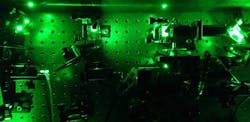University of Cambridge researchers observe elusive "squeezed light"
Squeezing is a strange phenomenon of quantum physics. It creates a very specific form of light that is "low-noise" and is potentially useful in technology designed to pick up faint signals, such as the detection of gravitational waves. In an experiment that had been written off in physics textbooks as impossible to observe, a team of scientists has successfully measured particles of light being "squeezed".
RELATED ARTICLE: Squeezed light bring quantum-enhanced contrast and resolution to bioimaging
The standard approach to squeezing light involves firing an intense laser beam at a material--usually a nonlinear crystal--that produces the desired effect. For more than 30 years, however, a theory has existed about another possible technique. This involves exciting a single atom with just a tiny amount of light. The theory states that the light scattered by this atom should, similarly, be squeezed.
Unfortunately, although the mathematical basis for this method--known as squeezing of resonance fluorescence--was drawn up in 1981, the experiment to observe it was so difficult that one established quantum physics textbook despairingly concluded, "It seems hopeless to measure it." Until now: In a Nature article, a team of physicists from the University of Cambridge (Cambridge, England) report that they have successfully demonstrated the squeezing of individual light particles, or photons, using a semiconductor quantum dot.
Like a lot of quantum physics, the principles behind squeezing light involve some mind-boggling concepts, beginning with the fact that wherever there are light particles, there are also associated electromagnetic fluctuations. This is a sort of static which scientists refer to as "noise". Typically, the more intense light gets, the higher the noise. Dim the light, and the noise goes down.
But strangely, at a very fine quantum level, the picture changes: even in a situation where there is no light, electromagnetic noise still exists. These are called vacuum fluctuations. While classical physics tells us that in the absence of a light source we will be in perfect darkness, quantum mechanics tells us that there is always some of this ambient fluctuation.
"If you look at a flat surface, it seems smooth and flat, but we know that if you really zoom in to a super-fine level, it probably isn't perfectly smooth at all," Atature said. "The same thing is happening with vacuum fluctuations. Once you get into the quantum world, you start to get this fine print. It looks like there are zero photons present, but actually there is just a tiny bit more than nothing."
This is when things get stranger still, however, because, in the right quantum conditions, that base limit of noise can be lowered even further. This lower-than-nothing, or lower-than-vacuum, state is what physicists call squeezing.
In the Cambridge experiment, the researchers achieved this by shining a faint laser beam onto their artificial atom, the quantum dot. This excited the quantum dot and led to the emission of a stream of individual photons. Although normally, the noise associated with this photonic activity is greater than a vacuum state, when the dot was only excited weakly the noise associated with the light field actually dropped, becoming less than the supposed baseline of vacuum fluctuations.
Explaining why this happens involves some highly complex quantum physics. At its core, however, is a rule known as Heisenberg's uncertainty principle. This states that in any situation in which a particle has two linked properties, only one can be measured and the other must be uncertain.
In the Cambridge experiment, the researchers used the Heisenberg uncertainty rule to their advantage, creating a tradeoff between what could be measured, and what could not. By scattering faint laser light from the quantum dot, the noise of part of the electromagnetic field was reduced to an extremely precise and low level, below the standard baseline of vacuum fluctuations. This was done at the expense of making other parts of the electromagnetic field less measurable, meaning that it became possible to create a level of noise that was lower-than-nothing, in keeping with Heisenberg's uncertainty principle, and hence the laws of quantum physics.
Plotting the uncertainty with which fluctuations in the electromagnetic field could be measured on a graph creates a shape where the uncertainty of one part has been reduced, while the other has been extended. This creates a squashed-looking, or "squeezed" shape, hence the term, "squeezing" light.
SOURCE: University of Cambridge; http://www.cam.ac.uk/research/news/scientists-squeeze-light-one-particle-at-a-time

Gail Overton | Senior Editor (2004-2020)
Gail has more than 30 years of engineering, marketing, product management, and editorial experience in the photonics and optical communications industry. Before joining the staff at Laser Focus World in 2004, she held many product management and product marketing roles in the fiber-optics industry, most notably at Hughes (El Segundo, CA), GTE Labs (Waltham, MA), Corning (Corning, NY), Photon Kinetics (Beaverton, OR), and Newport Corporation (Irvine, CA). During her marketing career, Gail published articles in WDM Solutions and Sensors magazine and traveled internationally to conduct product and sales training. Gail received her BS degree in physics, with an emphasis in optics, from San Diego State University in San Diego, CA in May 1986.
